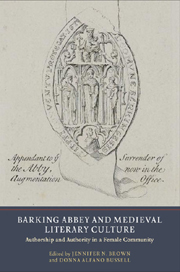Book contents
- Frontmatter
- Contents
- List of Contributors
- Acknowledgements
- List of Abbreviations
- Dedication
- Introduction: Barking's Lives, the Abbey and its Abbesses
- I BARKING ABBEY AND ITS ANGLO-SAXON CONTEXT
- II BARKING ABBEY AND ITS ANGLO-NORMAN CONTEXT
- 5 ‘Sun num n'i vult dire a ore’: Identity Matters at Barking Abbey
- 6 ‘Ce qu'ens li trovat, eut en sei’: On the Equal Chastity of Queen Edith and King Edward in the Nun of Barking's La Vie d'Edouard le confesseur
- 7 Body, Gender and Nation in the Lives of Edward the Confessor
- 8 Clemence and Catherine: The Life of St Catherine in its Norman and Anglo-Norman Context
- 9 Cicero, Aelred and Guernes: The Politics of Love in Clemence of Barking's Catherine
- 10 The Authority of Diversity: Communal Patronage in Le Gracial
- III BARKING ABBEY AND THE LATER MIDDLE AGES
- Afterword. Barking and the Historiography of Female Community
- Bibliography
- Index
- YORK MEDIEVAL PRESS: PUBLICATIONS
7 - Body, Gender and Nation in the Lives of Edward the Confessor
from II - BARKING ABBEY AND ITS ANGLO-NORMAN CONTEXT
Published online by Cambridge University Press: 05 April 2013
- Frontmatter
- Contents
- List of Contributors
- Acknowledgements
- List of Abbreviations
- Dedication
- Introduction: Barking's Lives, the Abbey and its Abbesses
- I BARKING ABBEY AND ITS ANGLO-SAXON CONTEXT
- II BARKING ABBEY AND ITS ANGLO-NORMAN CONTEXT
- 5 ‘Sun num n'i vult dire a ore’: Identity Matters at Barking Abbey
- 6 ‘Ce qu'ens li trovat, eut en sei’: On the Equal Chastity of Queen Edith and King Edward in the Nun of Barking's La Vie d'Edouard le confesseur
- 7 Body, Gender and Nation in the Lives of Edward the Confessor
- 8 Clemence and Catherine: The Life of St Catherine in its Norman and Anglo-Norman Context
- 9 Cicero, Aelred and Guernes: The Politics of Love in Clemence of Barking's Catherine
- 10 The Authority of Diversity: Communal Patronage in Le Gracial
- III BARKING ABBEY AND THE LATER MIDDLE AGES
- Afterword. Barking and the Historiography of Female Community
- Bibliography
- Index
- YORK MEDIEVAL PRESS: PUBLICATIONS
Summary
Edward the Confessor, whose death without an obvious heir permitted William the Conqueror to claim the English throne, left a varied hagiographical record. During his life, Queen Edith, his wife, commissioned the first vita from a monk of Saint-Bertin. This narrative ends with Edward's death and the arrival of William, omitting usual hagiographical addenda concerning miracles or other post-death stories concerning the saint. In 1138, Osbert of Clare follows with a more traditional hagiography, and a bid for Edward's canonization (which did not, in the end, happen until 1161). But it is Aelred of Rievaulx's 1163 vita, written for the translation of Edward's relics, that would shape all subsequent narratives about Edward's life. The first surviving vernacular translation of Aelred's vita is written in Anglo-Norman by the anonymous nun of Barking Abbey. Her Vie is dated between 1163 and 1189. This text is followed by Matthew Paris's renowned illustrated version, also in Anglo-Norman, dated c. 1230–50. While Paris may have been familiar with the nun's version, he does not draw from it, and instead uses Aelred's vita as his main source supplemented by other near-contemporary documents, such as Geoffrey of Monmouth's Historia regum Brittaniae. From 1300 to the first half of the fifteenth century, Middle English versions of the life were also produced in both prose and verse.
- Type
- Chapter
- Information
- Barking Abbey and Medieval Literary CultureAuthorship and Authority in a Female Community, pp. 145 - 163Publisher: Boydell & BrewerPrint publication year: 2012



